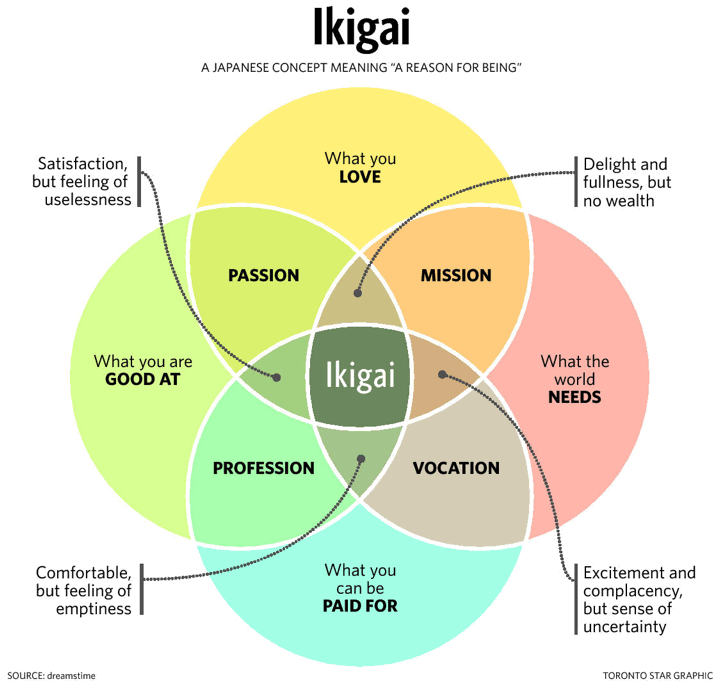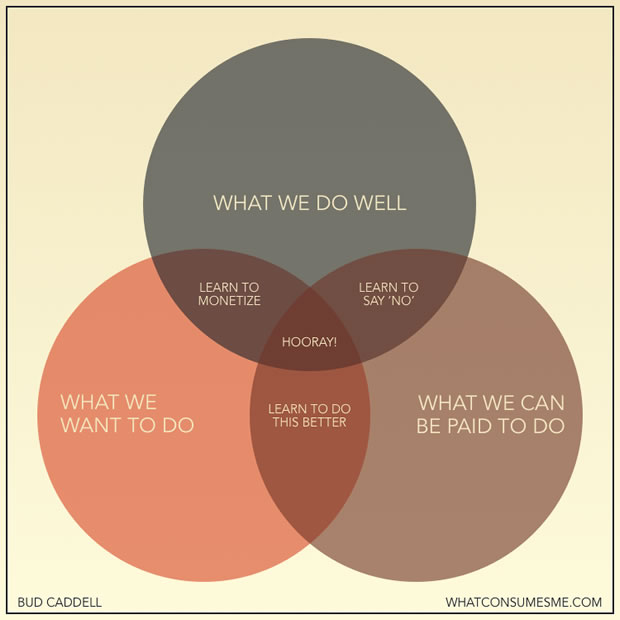
I stumbled across the concept of ikigai in Japanese culture – loosely translated as “reason for being” – in this Medium post. The Venn diagram above appears to be taken from this Toronto Star article (which is based on another work, and so on…). The graphic suggests that we asks ourselves these questions to find our ikigai:
- What do you love?
- What are you good at?
- What does the world need from you?
- What can you get paid for?
In other words, Ikagai is not just your passion or something that makes you happy. I searched for deeper explanations and found this BBC article with the most satisfying one:
Ikigai is what allows you to look forward to the future even if you’re miserable right now.
I was reminded of this previously-mentioned Venn diagram by Bud Caddell regarding finding the right job:

In essence, the question “What does the world need from you?” is collapsed into “What can you get paid for?” above. If you’re looking for the ideal job, then I suppose that is a good shortcut.
However, not everyone’s reason for waking up every morning involves money. The BBC article cites a 2010 survey of 2,000 Japanese men and women where just 31% of participants cited work as their ikigai. That means for 69% of Japanese people, their ikigai is something else. Family, friends, community, a hobby, a volunteer position.
Food for thought.
 The Best Credit Card Bonus Offers – 2025
The Best Credit Card Bonus Offers – 2025 Big List of Free Stocks from Brokerage Apps
Big List of Free Stocks from Brokerage Apps Best Interest Rates on Cash - 2025
Best Interest Rates on Cash - 2025 Free Credit Scores x 3 + Free Credit Monitoring
Free Credit Scores x 3 + Free Credit Monitoring Best No Fee 0% APR Balance Transfer Offers
Best No Fee 0% APR Balance Transfer Offers Little-Known Cellular Data Plans That Can Save Big Money
Little-Known Cellular Data Plans That Can Save Big Money How To Haggle Your Cable or Direct TV Bill
How To Haggle Your Cable or Direct TV Bill Big List of Free Consumer Data Reports (Credit, Rent, Work)
Big List of Free Consumer Data Reports (Credit, Rent, Work)
I have been practicing this without knowing it!
I could have picked a profession which I have slightly more liking for
but not without sacrificing a significant amount of earning potential.
end result is I chose my 2nd favorite thing to do as my profession
and I can surely say I am very happy that I did so.
Not the point of this exactly but I thought it was really encouraging for a work obsessed Japanese culture that a decent percentage of those polled define their ikigai as not their work. I’m hoping that it leads to a bit more balance. I’ve got friends working there and though I’ve always had a strong work ethic, the expectations for them even take me aback!
I think its a good concept. I also like the point that people don’t necessarily find their Ikigai in their jobs.
However, to nitpick… I think the graphic might paint a unrealistic picture. I think theres much more overlap in the 4 items. For example, the graphic seems to imply that you can only be paid for about 1/2 of what the world needs, or conversely that 1/2 of the jobs aren’t needed. But I’d counter that 90%+ of what the world needs is stuff that you can be paid for and 90%+ jobs are necessary things. Of course I don’t think we’re supposed to take the graphic as drawn “to scale” but its just to illustrate the point. However as it is, the graphic makes it look like finding Ikigai is very rare as it occupies a small % of all things.